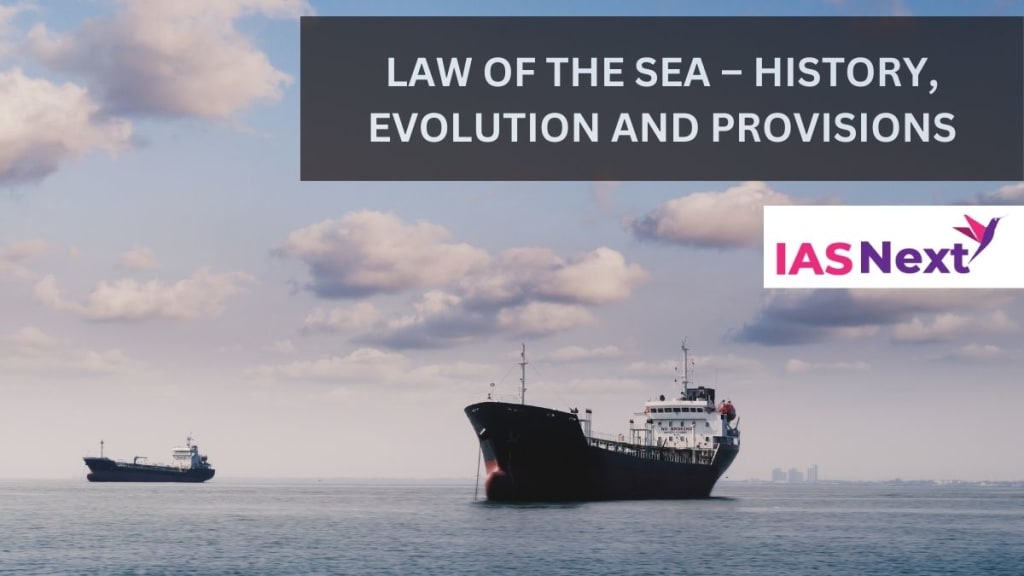Law Of The Sea – History, Evolution And Provisions
IAS NEXT is a topmost Coaching Institute offering guidance for Civil & Judicial services like UPSC, State PCS, PCS-J exams since more than 10 years.

Introduction
Law of the sea has developed steadily and gradually since the time of Grotius. Earlier the powerful States laid extensive claims of sovereignty over specific portions of the open sea. With the developments in trade and commerce in the 20th century and the realization of the inexhaustible use of the sea, the classic principle of ‘mare liberium’ or ‘freedom of the seas’ has been eclipsed.
The law developed out of well-settled usages culminating in customary law. The hallmark of this law, which was followed up to the half of the twentieth century, was essentially that of non-regulation and laissez-faire and except that of territorial waters, the law essentially endorsed the doctrine of ‘open sea’. But the United States declared proclamation jurisdiction over the continental shelf which gave a new direction to the law of sea. Many nations made sweeping claims to protect their economic and military interests. These developments stressed the urgency for the codification of law in order to strive uniformity and resolve maritime conflicts among nations. The matter was put on the agenda of the International Law Commission in 1949.
On the basis of the drafts prepared by the ILC, in 1958, the First United Nations Conference on the Law of the Sea took place at Geneva.
Geneva Convention on the Law of Sea, 1958
The convention was attended by 82 States, which adopted the following four conventions:
1. Convention on the Territorial Sea and the Contiguous Zone,
2. Convention on the High Sea,
3. Convention on Fishing and Conservation of the Living Resources
4. Convention on the Continental Shelf.
The most important issue which was left undecided was the breadth of the territorial sea. It was so because all the states were not agreeable to one and the same limit of the territorial sea.
Geneva Convention on the Law of Sea, 1960
In order to resolve this specific issue, Second Conference on the Law of Sea was held in 1960, at Geneva, but it again failed due to different claims of the States. However, it was realized that both these conference on the Law of the Sea were inadequate and left many matters unsettled.
This made it imperative to reformulate the law of the sea in composite form to make it conducive to the new interests and demands of all concerned and paved the way to hold the Third Law of the Sea Conference.
Third United Nations Conference on the Law of Sea
In 1967 the representative of Malta, Arvid Pardo gave a survey of the mineral resources of the sea-bed before the First Committee of the General Assembly of the United Nations. His survey coupled with the acute and urgent need of the minerals and other factors such as military and strategic aspects necessitated to lay down such laws which may possibly control and regulate the sea in a more effective way.
The move was to secure the mineral wealth of the oceans as well as to avoid the militarization of the deep seabed. This led to the formation of a 42 member Ad hoc Seabed Committee in 190, the General Assembly adopted a declaration of Principles Governing the Seabed and Oceans floor, and the Sub-soil thereof, beyond the limits of National Jurisdiction, which proclaimed that the exploitation of these areas should be carried out for the benefit of the mankind as a whole.
The First session of the Third UN Conference on the law of the sea was held in New York in 1973. At the end of nine years in 12 sessions, the Conference adopted the Law of the Sea Convention in 1982......Read More: Click here
Read Also:- Aliens – Admission, Expulsion And Rights Under International Law
About the Creator
Enjoyed the story? Support the Creator.
Subscribe for free to receive all their stories in your feed. You could also pledge your support or give them a one-off tip, letting them know you appreciate their work.





Comments
There are no comments for this story
Be the first to respond and start the conversation.